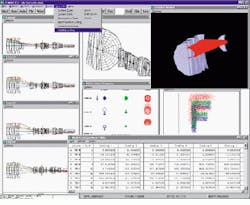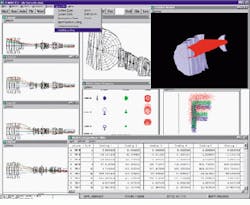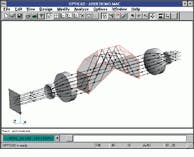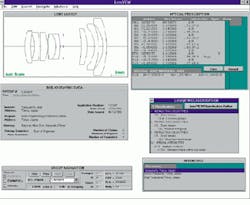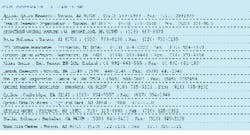SIMPLIFY LENS DESIGN WITH CAD SOFTWARE, THATS EASY TO USE
SIMPLIFY LENS DESIGN WITH CAD SOFTWARE, THAT`S EASY TO USE
By Randal Chinnock
Just a few years ago, developers of optical systems had few software choices to aid them in their designs. Although packages such as Beam from Stellar Software (Berkeley, CA), Oslo from Sinclair Optics (Fairport, NY), and Code V from Optical Research Associates (Pasadena, CA) were available, they ran on UNIX systems and were often accompanied by a high purchase or lease price. Of these packages, Code V was thought to be the most versatile, but the $10,000 per year lease placed it out of reach of many optical designers.
Over the past few years, a quiet revolution has been taking place in optical design software. From the days of Unix-based systems that only sophisticated optical designers could use, optical design software is now available in easy-to-use, Windows-based products. Today, optical design packages, which can be purchased for as little as $1500, allow sophisticated optical designs to be accomplished in a matter of weeks.
Lens design
Developers challenged with lens design represent the largest market for optical design software. Whether they are working on microscopes, telescopes, camera lenses, or projection lenses, they need software that performs classical ray-tracing according to the principles of geometrical optics, where the propagation and diffraction of light through various media is calculated using Newtonian physics.
One limit of ray-tracing techniques, however, is that they cannot be used to design elements smaller than about 10 wavelengths of light. They are also unsuitable where coherent and near-field effects are involved, such as in some lasers and microelectro-optical design.
Zemax from Focus Software (Tucson, AZ) is typical of the newer optical design packages available. Founder, software designer, and president Ken Moore will not say how many copies of Zemax his company has sold, but he claims an 85%-90% share of the optical design market. Jim Howard, president of OSTI (North Billerica, MA), designs infrared (IR) equipment with Zemax. "Zemax has replaced Code V as our software of choice. It has more capabilities and is easier to use," he says. Howard especially likes the Zernike polynomial function that uses interferometric data from real lens elements to predict system modulation-transfer functions.
Zemax is Windows 3.0/`95/NT-based software that can perform tolerance analysis of designs, including the use of Monte Carlo simulation, where system performance is repeatedly calculated as system variables are set in random combinations at their tolerance limits (see Fig. 1). The result is a "statistical expectation of meeting specification," a valuable number to have.
Dr. Magnante at Brookfield Optical Systems (Brookfield, MA) used Zemax for a pinhole lens design. In his design, Magnante developed a camera lens 0.375 in. in diameter to look through a 0.032-in.-diameter hole. The lens also had to have the light-gathering capability of a TV camera, zoom feature, and scan a field of view of 120o. "Zemax`s multiconfiguration feature allowed various wavelengths, mechanical constraints, zoom positions, scan positions, and field angles to be optimized simultaneously," Magnante says. "I also defined a merit function based on key parameters. This allowed the software to optimize the performance of the lens."
Zemax has pull-down menus for glasses from all the major manufacturers, eliminating the need to refer to optics catalogs. The software contains catalogs of lenses and mirrors and can also automatically tailor a new design using the test glasses--"masters" grounded and polished to the same radius as a lens to be fabricated --stocked by various US manufacturers. By placing a lens on a test glass, the resulting position of interference fringes reveals how well the lens surface conforms to the ideal. This saves a lot of time and money in prototyping.
Xiaohui Ning, vice president of science and technology at AOtec (Southbridge, MA), has used Zemax to design a head-up display. "I designed the system in less than a week, including tolerancing," Ning reports. "It was a diffractive hybrid design and worked the first time."
Nonsequential ray-tracing
Packages such as Zemax, which are sequential ray-tracers, are limited in performing unconstrained ray-tracing, reflection, refraction, scattering, and illumination. But non sequential ray tracers are available to solve this problem. With such packages, each ray segment can be independently defined, allowing the engineer to develop systems in which light behaves in complex ways. Such a Windows 3.0/`95/NT-based package, OptiCAD from The Opticad Corp. (Santa Fe, NM), models and optimizes systems with multiple point or extended sources, multiple reflections, and rough surfaces that cause significant stray light (see Fig. 2). This makes it well suited for systems that require multiple optical paths to be plotted.
Michael Leveille of Waters Corp. (Millford, MA) uses OptiCAD to model flow cells and capillary tubes used in the company`s liquid chromatography systems. "We needed the nonsequential ray-tracing feature to model how rays act as they traverse glass tubes," Leveille says. "OptiCAD allows us to enter absorbtion coefficients for the sample that`s flowing through the core of the tube."
Some users complain about OptiCAD`s user interface. Moore of Focus Software distributes OptiCAD and acknowledges its interface problems. According to Moore, Version 4.0, released this month, will greatly improve the interface.
With its coming improvements, OptiCAD may be a good choice for designing illumination systems, including lamps, reflectors, tapers, light pipes, and lenses. Complex lighting demands of automotive instrument clusters are an application where designers want to illuminate a variety of surfaces and volumes with a single source. The package can handle diffuse surfaces and faceted reflectors such as those used in projection lamps. OptiCAD can also exchange IGES files with CAD programs, easing system integration. Nonsequential ray-tracing alternatives to OptiCAD include Lighttools from Optical Research Associates, ASAP from Breault Research (Tucson, AZ), and TracePro from Lambda Research Corp. (Groton, MA).
Unusual systems
Originally developed at the Scientific Calculations Division of Harris, ACCOS is now sold by Optikos (Cambridge, MA). President Stephen Fantone believes the software is most useful for modeling and optimization of special and unusual systems. He cites an IR data-link design that was required to couple an LED to a detector. "The squarish LED die emitted light from its top and its sides, so it was placed in a parabolic reflector to collect the side-emitted light," Fantone said. Above the die was an aspheric lens to collect light from the top and collimate the output. "This was an unconventional problem."
The package, which runs on Unix, DOS, and Windows NT, is targeted at the sophisticated user, Fantone says. Other available software that targets such designs includes Code V from Optical Research Associates and Oslo Six from Sinclair Optics.
Physical optics
Ray-tracing approaches, both sequential and nonsequential, cannot solve a variety of problems associated with physical optics. Physical optics treats light as a wave phenomenon, where light propagation is studied by wavefronts rather than rays, as in geometrical optics.
To solve these physical optics problems, the Glad software package from Applied Optics Research (Pasadena, CA) uses a complex amplitude description of wavefronts that allows modeling of diffraction throughout the propagation path of the optical beam. This allows designers to determine laser gain, calculate nonlinear optics, and model coherent and incoherent interactions and other physical effects. Applications include commercial laser design, laser research experiments, resonators, photolithography, waveguides, and phase plates.
Dick Blake at Sandia National Laboratories (Albuquerque, NM) used the package to model beam expanders and assist in the calibration of lasers. Blake found the program easy to use, provided, he says "you are fairly advanced in geometrical and physical optics."
Coating design
A bane of optical designers is stray light. Stray light veils images, reduces brightness, and causes unwanted crosstalk. Depositing thin films onto optical elements reduces this problem. High-quality lenses must be antireflection-coated to reduce reflections caused by the change in refractive index at the surface of the lens (generally an air-to-glass interface).
For visible applications, the most common antireflection coating is magnesium fluoride, which reduces reflectivity from several percent to about 1%. A high-efficiency antireflection coating contains multiple layers of different materials and can reduce reflections from 0.05% to 0.5%. Some designs call for highly reflective surfaces. Here, transparent substrates are coated with metals such as silver and aluminum to provide high reflectivity. Dichroic filters can also be created by depositing "stacks" of coating layers onto transparent substrates so that the filters only pass certain wavebands of light.
Most optical designers do not design coatings. Generally, they provide the specifications for the coating, and the coating process is sent to a specialized manufacturer. However, when designing a high-power laser system, when polarization effects are important, or when other unusual requirements exist, it may be necessary to take on the coating task. Here, the MacLeod package from the Thin Film Center (Tucson, AZ) is the software package of choice. MacLeod can model the impulse response of coatings subjected to ultrafast light pulses, such as those used in telecommunications applications. It can also function in conjunction with Zemax, to allow for a higher-level of system optimization.
Where to start
One of the most difficult aspects of optical design, especially for the novice, is knowing where to start. For the inventor, patent attorney, design engineer, or project manager, the Windows 3.0 and `95-based LensView package from Optical Data Solutions (Highland Park, NJ) contains most of the optical designs found in the US patent literature from the late 1800s to the present. These include drawings, optical prescription data, inventor information, and sample claims text (see Fig. 3). Its database engine allows the designer to search by lens type, focal length, and magnification. Data also can be exported in Zemax, Code V, and other formats.
To choose a lens, designers could specify a 28-mm, f/2.8 fixed-focal-length lens, for example, and modify the designs the package finds. Patent-infringement issues may be a consideration, although patents on many of the designs have expired, and it is often not difficult to change such designs so they do not infringe any patents. The latest release of the software offers 18,000 lens designs. And, for $2000, including a year of quarterly updates, it is reasonably priced.
No panacea
As the list of available optical design software packages continues to grow, each package is finding a specific design niche (see table). Each package is best for certain tasks and limited for others. Some packages are practical for the occasional designer, while some require hundreds of hours of learning to become proficient.
Most important, the inexperienced designer must consider the cost, fabrication, assembly, and test issues associated with design. Optical design software cannot always answer questions such as what shapes of lenses can be economically fabricated, what tolerances can be achieved at reasonable cost, and what materials are best to work with.
Most prototypes cost many thousands of dollars and generally take 8-16 weeks to fabricate, so while the software costs are low enough for the novice to experiment with, it is best to consult an experienced designer before you cut glass.
FIGURE 1. Zemax can model zoom lenses of arbitrary complexity. Here, a nine- position zoom lens is shown in four different zoom positions simultaneously. Also shown is a shaded model image of a portion of the lens, a spot diagram, and an extended source image.
FIGURE 2. Opticad can perform a nonsequential ray-trace of an Abbé prism.The collimated beam entering from the left passes through a beam expander and then through an Abbé prism with an internal roof, and finally through a beam reducer.
FIGURE 3. LensVIEW is a Windows-based package that enables designers to search a lens database, list lens data, and draw graphics.
